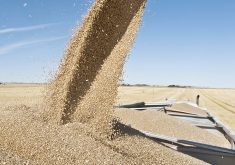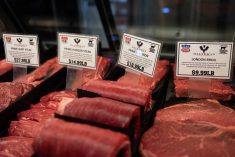Jacob Quantz left Ontario in the 1880s to homestead in what is now central Alberta.
He and his wife, Sophie, named their quarter section The Jungle Farm.
The couple had two sons: one was killed in the First World War and the other, Oscar, returned to the farm.
Jacob’s great-granddaughter, Leona, and her husband, Blaine Staples, have been farming here since 1996. The farm was recognized for its centenary in 1997.
Leona has a degree in home economics and Blaine has a master’s degree in agriculture. The main farm produces oilseeds and cereals, but they also grow 16 to 20 acres of strawberries and a similar amount of vegetables.
Read Also

India slaps 30 per cent import duty on yellow peas
India has imposed a 30 per cent duty on yellow pea imports with a bill of lading date on or after Nov. 1, 2025.
Leona welcomes more than 2,000 schoolchildren and family groups to the farm during the growing season.
“People want to know what is going on at the farm,” she said.
“They are fascinated with how their food is grown.”
A former district home economist for Alberta Agriculture, she also offers classes on preserving and teaching modern women how to make jam, pickles and sauerkraut.
“Extension has been my life. I think it is my calling to share agriculture with kids,” she said.
The family also hosts dinners in their red barn, working with neighbouring farmers to create a full menu.
They run a U-pick fruit operation and also grow vegetables for farmers’ markets and local restaurants.
They are one of five family farms that comprise Innisfail Growers, which direct sells products at farmers’ markets.
The farm is a thriving operation, but like all family operations, it must deal with plenty of hard work, struggles against unwanted insects, worry over late frosts and mid summer hailstorms that can smash away an entire year’s work in minutes.
This is their diary.
It is 12 C and partly cloudy. The greenhouses are full of tiny seedlings in flats.
A germination chamber similar to an incubator to hatch eggs has been started to accelerate germination. Seeds were placed in little peat plugs and go inside the chamber. Two days later tiny seedlings have emerged.
The warm environment is housing artichokes, lettuce, cabbages, broccoli, kohlrabi, herbs, celery, tomatoes, onions and flowers.
This year they are also trying melons.
The vegetables are at various growth stages from two leaf to full plants. They will be transplanted outside as soon as the danger of frost is gone.
Customers were invited to come to the farm in April to make their own flower pots full of colour and variety. These are ready for pickup along with special Mother’s Day arrangements. There are plenty of pansies, lilies and trendy new black petunias that are a deep purple with light variegations of colour.
The greenhouse opened to the public May 6.
Four Mexican men and a University of Lethbridge education student are already on hand to start the season.
Hanging strawberry baskets that were started in March are already producing plump red fruit for the early days of May.
Some of the raspberry canes are being pruned, but the straw mulch could not be removed from the strawberry fields because it is too wet.
The dugout used for irrigation is full to the brim. Drip irrigation is used when necessary.
Spinach planted in the fall is well on its way. Spinach ordinarily planted in April was delayed a month because of snow in the field.
Cool weather continues with a touch of frost at the beginning of June that damaged the strawberry blossoms.
Blaine has finished seeding the canola and wheat. This was followed by a rush to deliver wheat to the elevators because grain cars are finally available.
A wide variety of cucumbers, squash, pumpkins, musk melon and watermelons called Sugar Babies have been planted in the greenhouse. These will be transferred outdoors later.
Onions, celery and spinach are outdoors, covered with perforated plastic tunnels to keep them safe from the elements, but some of the lettuce suffered frost damage.
Staff raked the mulch off the strawberries by hand in mid-May because it was too wet to remove by machine. However, the mulch did its job and protected the plants on eight acres from winter kills. Some other fields were damaged over the winter.
Bell peppers adapted to the prairie climate are ready to go outside soon. The farm is working with the University of Saskatchewan to try new peppers called Redskin and Socrates to see how they produce outdoors in central Alberta.
On June 3, 10 dozen nine ounce jars of strawberry jam were made to sell at the Calgary Farmers’ Market. These should be enough for two weekends’ worth of sales.
Plenty of aphids were discovered on the bedding plants and flower arrangements in the greenhouse, so ladybugs have been released to stay ahead of the problem.
The temperature on July 18 was 29 C. Humidity is 80 percent so the garden is growing well. The area was surrounded by thunderstorms and the following day hail pounded down in the late afternoon. The damage is still being assessed.
The first strawberries are ready for harvest July 18. Day neutral varieties work best in this growing region. The workers are pulling out the strawberry runners to make plants grow big.
Watermelons are still under plastic. The foliage looks like oak leaves. The celery is a foot tall and the artichokes are almost ready.
Pickling size cucumbers are ready and the zucchini and squash are blooming. Chefs are requesting zucchini with the blossom on for a gourmet treat.
The leeks and Walla onions are ready for picking.
The cereals and canola are growing well. The entire countryside is yellow with blooming canola.
Three-quarters of a centimetre of rain fell Aug. 14 and the days are cooler than normal, so some crops are slow to mature.
The spaghetti squash is about the size of a cantaloupe and the watermelon is the size of a table tennis ball.
The U of S field peppers project has produced green peppers about the size of tennis balls. They are sweet and tasty. Pepper plants are also offered in the greenhouse in containers. Some are starting to turn red.
Artichokes are ready for the restaurant trade. The chefs prefer tiny ones.
About 800 pounds of cucumbers were picked over the weekend. Plants such as cucumbers and zucchini bounced back well after a mid-July hailstorm, although some still show damage.
Strawberries finished Aug. 13 and raspberries are resplendent.
Strawberry clippings have been gathered and are rooting well. These were to be seeded this fall for early emergence next spring.
Garden mums are almost ready. These are started from clippings and will produce fall flowers of red, bronze and yellow.
Tillage radishes have been seeded in a former rye field. They are planted four weeks before frost and leave a long root that leaves a long narrow hole. This will be a new strawberry patch next year.
Summer has been cool. The melons would have been more successful with more heat.
The sweet corn was damaged in the July hail storm and has not recovered by Aug. 15. Leona is not sure there will be much production.
Temperature is 14 C.
There was a touch of frost the night before so fall strawberries are covered with special fabric to save them.
They try to control the effects of weather with blankets and raised beds. The ground is warm in the fall, even if the nights are cold, so plants can continue growing.
Still, the upper canopy of squash, pumpkins and watermelon are showing frost damage so the fruit needs to be picked.
“This is the wettest summer I have ever seen. There are times I couldn’t get into the field with the tractor,” said Blaine.
Harvest is far off. The canola was cut but the cereals are not ripe, even though some September days were 30 C.
There were plenty of aphids this summer. Ladybugs were released for the greenhouse, but the proliferation of aphids in the field encouraged the little red insects to appear on their own in the artichoke patch.
Fall planted spinach is already up and will be ready for the first spring picking in 2012.
Combining was finished Oct. 17. There was some regrowth in the barley, so Blaine is worried about his malt prospects.
Acorn squash has been picked just before the last big frost. It is a popular item because many customers like to make it into baby food. They also grow Hubbard squash for soups and stews.
The storage onions are being packaged. The Walla Walla onions store well only until October. Some new varieties are sweeter than Walla Walla, so they may be considered another year.
The pumpkins are ready for Halloween.
Traditional type pumpkins are offered, but they also grow varieties called Goosebumps and Knuckleheads, which are covered with bumps. These were once considered mutants before an interested grower started selecting them. They are now growing in popularity because of their unusual look.
Blaine has started new strawberries for next spring’s planting. These are a day neutral type that keep over winter at a cool, steady temperature so they can produce fruit in June.
The strawberry fields will be covered with wheat straw in mid-November after they have gone into dormancy.
Merry Christmas at the on-farm market.















